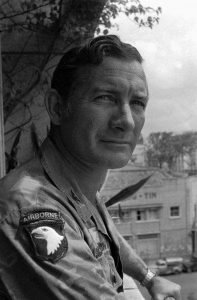The US Army’s ‘Tiger Force’ Took Terror Tactics to the Viet Cong

By Blake Stilwell, We Are The Mighty
By 1967, the United States was firmly committed to the war in Vietnam. That year saw 485,600 American troops in country. That’s like arming the entire population of Kansas City and moving them into another country.
So yeah, they were invested.
But from the start, the Vietnam War was unlike the previous American wars. There was no real front, the enemy could be anywhere, and most importantly, they didn’t always fight like a conventional army in the mountains, jungles, or rice paddies.
The Americans were fighting a limited war, trying to keep North Vietnam from infiltrating or taking over the South. They were also using a data-driven (but flawed) campaign of bombing and other operations based on pursuing and exploiting the fears and beliefs of the North Vietnamese.
Enter then-Maj. David Hackworth.

Hackworth was tasked with creating an elite commando unit from the already elite Special Forces long range reconnaissance patrol units. The mission of what he would call Tiger Force was more than just intelligence gathering. As he put it, he wanted to “out-guerrilla the guerrillas.”
In 1967, Hackworth was out of the unit, and it was assigned to Vietnam’s Central Highlands, where it conducted a six-month long terror campaign in the Song Ve Valley and as part of Operation Wheeler. The mission was so brutal and so deep in enemy territory, members of the Tiger Force did not expect to survive.
In a war where the U.S. military relied on body counts as a measure of success, Tiger Force was ready to do its part. Hackworth once noted, “You got your card punched by the numbers of bodies you counted.”
Tiger Force went into villages the Viet Cong relied on for support and shelter in the Spring and Fall of 1967 and drove the villagers out of their homes using brute force. They allegedly used some disturbing methods to achieve those ends.

The Toledo Blade’s Michael D. Sallah, Mitch Weiss, and Joe Mahr (right) won the 2004 Pulitzer Prize for their eight months of investigation and reporting on the alleged war crimes committed by Tiger Force.
“Women and children were intentionally blown up in underground bunkers. Elderly farmers were shot as they toiled in the fields. Prisoners were tortured and executed — their ears and scalps severed for souvenirs. One soldier kicked out the teeth of executed civilians for their gold fillings.”
The three journalists say the Army commandos, far from friendly areas and left without support, routinely violated the laws of armed conflict, killed unarmed civilians, dropped grenades on women and children, and covered up the incidents during the official Army investigations.
Some members of the Tiger Force today aren’t even disputing the allegations. Doyle, along with others, claims to have lost count of how many people they killed.

”I’ve seen atrocities in Vietnam that make Tiger Force look like Sunday school,” Doyle told the New York Times. “Everybody I killed, I killed to survive. They make Tiger Force out to be an atrocity. Well, that’s almost a compliment. Because nobody will understand the evil I’ve seen.”
The Army investigated the allegations for four and a half years but no charges were ever filed and the men of tiger Force became some of the most decorated in the Vietnam War. They were even awarded a Presidential Unit Citation.
For its part, the Army told the Toledo Blade that, barring any new evidence coming to light, the investigations would remain closed, even after comparing the newspaper’s information with their official records.

We Are The Mighty is a veteran-led digital publisher and Emmy-award-winning media agency servicing brands with video production, marketing, advertising, and consulting services to engage with the military community. In addition to our digital publisher, we also run the Military Influencer Conference, the largest in-person event servicing our military community. WATM is owned by Recurrent Ventures and is a GSA approved vendor.
BRCC and Bad Moon Print Press team up for an exclusive, limited-edition T-shirt design!
BRCC partners with Team Room Design for an exclusive T-shirt release!
Thirty Seconds Out has partnered with BRCC for an exclusive shirt design invoking the God of Winter.
Lucas O'Hara of Grizzly Forge has teamed up with BRCC for a badass, exclusive Shirt Club T-shirt design featuring his most popular knife and tiomahawk.
Coffee or Die sits down with one of the graphic designers behind Black Rifle Coffee's signature look and vibe.
Biden will award the Medal of Honor to a Vietnam War Army helicopter pilot who risked his life to save a reconnaissance team from almost certain death.
Ever wonder how much Jack Mandaville would f*ck sh*t up if he went back in time? The American Revolution didn't even see him coming.
A nearly 200-year-old West Point time capsule that at first appeared to yield little more than dust contains hidden treasure, the US Military Academy said.












